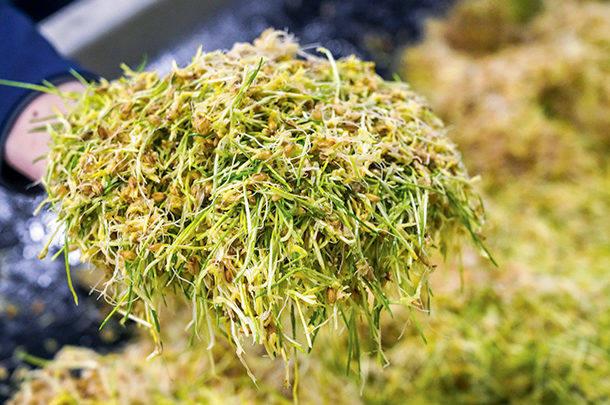Forages are by weight the main component of dairy cow rations greatly influencing production, profitability and cow well-being. High-quality digestible forages help cows face the challenges derived from the increased nutrient demands of peripartum and lactation.
During the last three weeks of gestation, the protein and energy needs of the cow increase as the result of development of the fetus and udder and colostrum synthesis. Concomitantly, intake drops by nearly 30%, predisposing cows to metabolic problems and infections. One nutrient deficiency during this period with the widest range of deleterious effects on cow productivity and well-being is hypocalcemia. Low blood calcium can result in a higher risk of dystocia, uterine prolapses, retained membranes, mastitis, displaced abomasum, overall reduced immune status and even death.
Recent advances in hydroponic cultures have allowed the production of quality forage under controlled conditions. The same amount of feed is produced year round using a fraction of the water and land required by traditional forage-production systems. Table 1 shows the nutrient composition of the commercial hydroponic wheat culture Hydrogreen compared with alfalfa hay and wheat straw.

Important nutritional aspects of this hydroponic culture are moderate crude protein (CP), low fiber (NDF and ADF), high sugar and starch concentrations, and low potassium.
Compared to Hydrogreen at similar protein concentrations, alfalfa has almost three times more acid detergent fiber (ADF), two times more neutral detergent fiber (NDF), five times more potassium, 4.8 times less sugar and 14.5 times less starch. The presence of more sugars and starch promotes rumen microbial growth, increasing metabolizable protein and enhancing rumen fermentation. Using high-quality forages such as alfalfa during this period is not recommended since it can contain roughly 2%-3% potassium and can increase the overall concentration of this mineral in the diet. It has been reported that reducing the potassium concentration to 1.1% of the diet prevents clinical hypocalcemia. An alternative to reduce dietary calcium and potassium and supply enough effective fiber is to include wheat hay or straw in the diet. Wheat hay, however, does not supply enough nutrients to the microbial population, such as soluble protein, sugars and starch. It also has almost three to four times more potassium than Hydrogreen and 62% less energy. The question is, how might these differences affect dairy cow performance in a commercial farm setting?
During 2021, our team conducted an experiment feeding a source of hydroponic forage to transition Jersey cows. In 2020, the American Jersey Cattle Association ranked this farm as first in fat production, third in milk protein and fourth in milk production. The feed supplement tested consisted of hydroponic wheat (HydroGreen) produced in a fully automated, indoor controlled environment in the company’s facilities in Sioux Falls, South Dakota. Early feeding observations suggested that hydroponic wheat positively influences intake, rumination and nutrient digestibility. The experimental diets, formulated with and without Hydrogreen, also contained wheat straw, low-potassium alfalfa hay, corn grain, anionic salts, vegetable bypass protein, canola meal, soybean meal, corn silage and water (Table 2 and 3).


Measured throughout the on-farm trial were milk production (daily with GEA milk metering and reported to DC305), rumination (CowManager sensors), and weekly samples to test total mixed ration (TMR) composition and digestibility (Rock River Laboratory).
Milk weights were consistently higher during the first three months of lactation for cows fed hydroponic wheat both during the close-up period and milking (Figure 1). Taking into consideration that each pound of increased peak milk results in approximately 200 more pounds overall in the lactation, the increased income was estimated at $126 per cow at current milk prices. This increase was of almost 5% across all lactation groups (adjusted for seasonality).

Cows fed the hydroponic wheat as part of their diet had better rumination response both pre- and post-calving, increasing by 12% (Figure 2). The group speculated this was the result of improved rumen-fermentation conditions. The incidence of metritis dropped significantly after cows were on hydroponic wheat for six months. In all adult animals, the average monthly metritis incidence was 19.8% dropping to 16.1% when hydroponic wheat was part of the diet.

In summary, this on-farm demonstration showed that hydroponic wheat positively affected rumination both during the close-up period and early lactation. This is important since reduced rumination resulting from lower intakes or sorting can predispose cows to metabolic disorders. There was also a positive effect on milk production during the first three months of the lactation.











